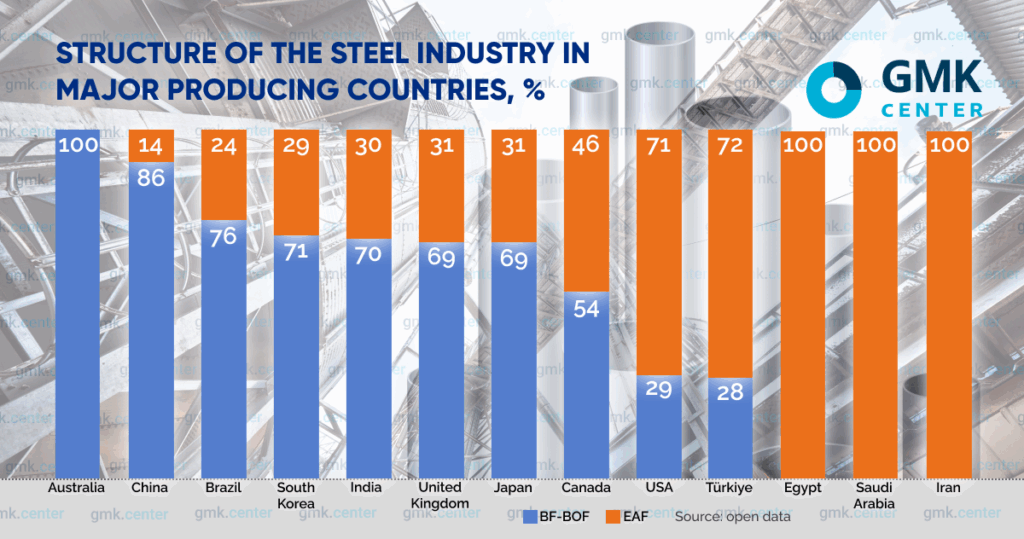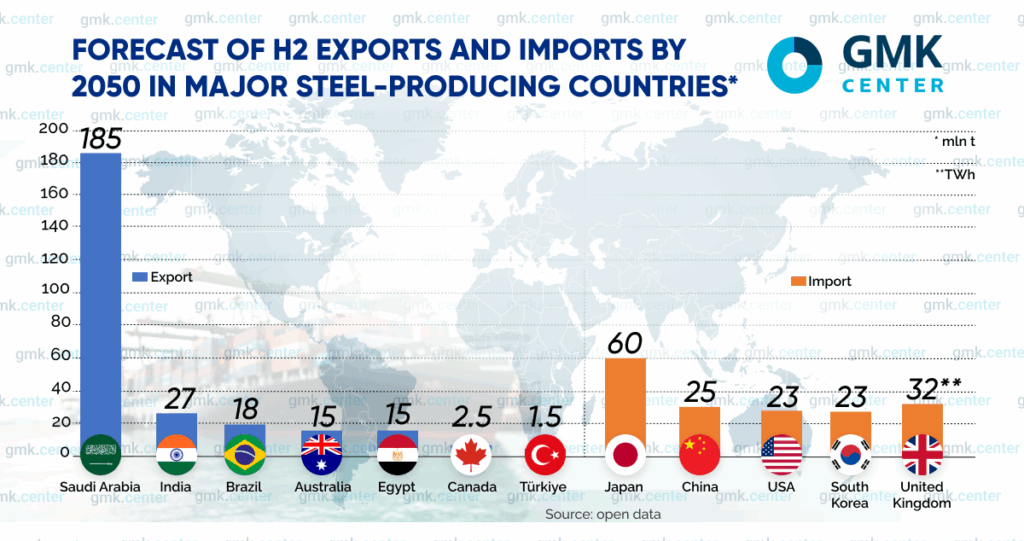Posted on 14 Oct 2025
The steel industry accounts for 7-9% of the world’s greenhouse gas emissions. Therefore, the process of gradual reduction of CO2 emissions from steelmaking has already been launched in most leading producing countries. The pace of progress varies, as it depends on a number of factors. So, what barriers do companies face and what incentives can accelerate the green transition?
Large coal reserves have made the BF-BOF route the dominant steelmaking method in China, India, Russia, Canada, Australia, Germany, the UK, Vietnam, South Africa, Indonesia, Ukraine, and other countries. Whereas the countries of the Gulf and North Africa, as well as Iran have huge reserves of natural gas. Therefore, all steelmaking here is based on the NG-DRI-EAF model (natural gas-based DRI production followed by steelmaking in electric arc furnaces).
There are exceptions to the rule. The US, the world’s third largest coal producer, produces most of its steel in electric arc furnaces (EAF). And vice versa. Despite having no coal mining capacity of its own, Brazil has built its steel industry predominantly on the BF-BOF route, using local charcoal.
Finally, there are countries with no metallurgical raw materials of their own. And they have made different choices in their time. Turkey relied on the construction of EAF plants, while Japan and South Korea relied on integrated mills.

Given that the BF-BOF steelmaking route emits an average of 2.2 to 2.4 tons of CO₂ per ton of steel, compared to just 0.4 to 0.7 tons for the EAF process, it’s clear which technology has the advantage in decarbonization. Steel products in the Gulf and North African countries, as well as Iran, are already virtually green.
Whereas the rest will have to invest heavily to achieve even that level. And the higher the share of BF-BOF mills in the national steel industry, the more investment is required. But where to invest?
Currently, 2 ways of decarbonization are known. The first one is replacement of BF-BOF capacities by NG-DRI-EAF, with further prospect of transformation into H2-DRI-EAF (DRI production using hydrogen with subsequent steelmaking in electric arc furnaces). This strategy has been chosen by:
* British Tata Steel UK and British Steel for the Port Talbot and Scunthorpe steelworks. The projects cost £1.25 billion and £2 billion;
* ArcelorMittal North America and Algoma Steel of Canada for the Dofasco and Algoma mills. The projects cost $1.8 billion and $880 million;
* British Liberty Steel for Australia’s Whyalla Works. The cost of the project is $485 mln;
There are fully completed cases as well.
The advantage of this way is that it is based on the best available technologies (BAT). This means that the results of their implementation and payback can be confidently predicted. Whereas the second currently known decarbonization route, the use of hydrogen in blast furnaces, is still at the stage of searching for optimal solutions.
* The US Cleveland-Cliffs in January 2024 at its Indiana Harbor mill completed trials of H2 injection into blast furnace No. 7, the largest in North America;
* India’s Tata Steel in April 2023 conducted a successful hydrogen injection trial in BF at its Jamshedpur mill;
* Turkey’s OYAK Mining & Metallurgy in 2024 completed a hydrogen injection trial in BF at its Erdemir mill;
* Japanese Hydrogen Steelmaking consortium of Nippon Steel, JFE Steel and Kobe Steel built small 2 pilot BFs at East Nippon Works in Kimitsu and JFE Steel in Chiba in 2023 for research on H2 utilization in blast furnace production;
The use of hydrogen in blast furnaces has limited potential to reduce CO2 emissions (up to 20%) and may not lead to low-carbon steel production, unlike electric arc furnaces and DRI produced using hydrogen.
According to Hideoki Suzuki, Nippon Steel’s Executive Director for Environment, the use of H2 in blast furnaces does not imply complete abandonment of coke. Therefore, the remaining volume of greenhouse emissions is planned to be neutralized using CCUS technology (capture, storage and use of CO2). Now it is far from industrial implementation.
It is all about the cost. Nippon Steel has managed to achieve a cost of carbon capture at $149/t CO2 and this is the best achievement so far. Obviously, this is too high a cost per 1 ton of finished steel. Plus dependence on technical solutions in related industries, primarily in terms of carbon transportation and storage. Therefore, it is very difficult to predict progress.
Under these conditions, many players do not have long-term decarbonization programs. Targets are limited to reducing CO2 emissions by 10-25% by 2030-2035 through BAT. Among them are all major Brazilian and Russian steel companies, Canadian Stelco, Japanese Kobe Steel, Australian Steel Products Ltd. (part of BlueScope Corporation), and others. Nevertheless, in accordance with national commitments, steelmakers in most countries must switch to carbon-neutral production by 2050. In China and Russia – by 2060, in India – by 2070.
ArcelorMittal North America in Canada and Liberty Steel Australia are also planning to build DRI plants with annual capacities of 2.5 million t and 1.8 million t as part of decarbonization. Having such a facility in the future will strengthen the market position of these companies.
But many will have to look for third-party suppliers. First of all, those who now use steel scrap to operate their EAFs. Its availability on the global market will decrease as more and more EAF facilities are built, including to replace existing BF-BOFs.
For instance, in China, no new BF-BOF projects have been approved by the authorities in 2024. According to the Centre forResearch on Energy and Clean Air, permits were issued only for the construction of EAF plants with a total capacity of 7.2 million tons per year.
According to forecasts by the consulting company Wood Mackenzie, the share of EAF in global steel production by 2050 will rise to 48% compared to 29.1% in 2024. According to various estimates, the operation of these facilities will require about 1 billion tons of scrap per year – while its procurement in 2024 amounted to 460.6 million tons.
Steelmakers cannot expect a twofold increase in scrap procurement. Moreover, more and more countries are resorting to protectionist measures with regard to steel scrap, regulating scrap export in one way or another. Or even banning it completely.
That’s why the importance of DRI, HBI, and CBI is growing – along with the role of countries that can supply these low-carbon iron ore materials to steelmakers lacking the conditions to produce them domestically.
First of all, the Gulf States, North Africa, as well as Iran, Australia, Brazil, Canada and Ukraine could become such suppliers. And they are very interested in such a scenario. Therefore, a number of new projects are being prepared for launch.
Production of green H2 is an extremely energy-intensive process. Moreover, it requires “green” electricity. It is obvious that not everyone has such potential for solar energy as the Gulf countries, North Africa, Australia, Iran and Brazil. Or hydropower like Canada.
Therefore, they are the ones that can become suppliers not only of green DRI/HBI/CBI, but also of green H2 for the steel industry in other countries. On this basis, the decarbonization strategy in China, Japan, South Korea, UK, EU states – envisages significant hydrogen imports by 2050.

It is expected that by then its price will have fallen to $1500/t . This should be a commercially acceptable offer. Currently, the cost of producing “green” H2 in different countries ranges from $5000/t to $12000/t. And the cost of transportation is about the same as the price of the product itself. This shows well how far hydrogen decarbonization is now from market realities.
Achieving carbon neutrality of the economy within each individual country is not the problem of CO2 emitters themselves, including metallurgists. It is a national task. Where the authorities understand this, decarbonization of the steel industry moves much faster.
This aspect is extremely important. Because in Ukraine, for example, emitters are also charged a fee for emissions. It goes to the general fund of the state budget and to the State Energy Efficiency Fund. Where it is spent on current needs.
With this approach, the state will never have the capacity to finance the green transition. Neither in steelmaking, nor in other industries. And without government involvement, such projects are often unaffordable for companies. For example, in Brazil the total cost of decarbonization of the steel industry is estimated at $29.19 billion, in India – $283 billion, etc.
Although there are nuances here as well. Analysis of the situation shows that where there is strong tariff protection of the domestic market, steelmakers are able to move towards carbon neutrality even without significant government involvement. For example, in the USA, Canada and Japan. And sometimes even without it, as in South Korea and Turkey. And vice versa.
The lack of effective barriers to cheap steel imports is the main challenge to decarbonization in Brazil, Australia, the UK and the EU. This sharply narrows the opportunities for steel companies to “green” production. And sometimes it simply nullifies them. As local players are forced to compete by reducing the profitability of their sales.
The introduction of CO2 emission trading systems (ETS) is considered an advanced way of carbon pricing. Currently, the emission trading system operates in the UK and the EU. From 2028, it will become operational in Brazil. In China and South Korea, the carbon market is functioning, but so far it applies only to the energy sector. Full participation by steel companies will start from 2026-2027.
However, emissions trading systems alone do not create incentives for decarbonization, which requires the development and deployment of new technologies. Alongside the ETS, government funding programs for decarbonization should also be in place to help offset the costs of R&D and large-scale industrial projects aimed at cutting CO₂ emissions.
Theoretically, CBAM, an additional tariff on imports of steel products with a high carbon footprint, could also contribute to decarbonization. In the EU, it will come into effect on January 1, 2026. The UK has also announced plans to implement such a mechanism after 2027.
But not everyone can follow the example of these. For example, the Canadian authorities have unofficially concluded that the CBAM is inexpedient. According to the Canadian Ministry of Finance, 76% of exports of local enterprises with high CO2 emissions go to the United States. Washington’s trade response to Canada’s CBAM would be too painful.
And, finally, the priority of greenf steel in public procurement. So far, it has been legislated only in India and Japan. However, under Japan’s GX Leadership Act, “balanced steel” is defined as low-emission steel produced using the traditional BF-BOF method – without any reference to EAF-based steel.
As a result, incentives are directed toward decarbonizing BF-BOF capacity, while companies that already produce green steel without additional support are discriminated. This is obviously a very serious legislative gap. It is important to pay attention to it where similar initiatives are just being prepared for adoption.
So, decarbonization of the steel industry in many countries is facing big challenges. These are the need to develop new technologies, to attract investment for this development and implementation, the need to compete with traditional steel products, which are cheaper. Reasonable government policy and market regulation can accelerate their solution.
Source:GMK Center